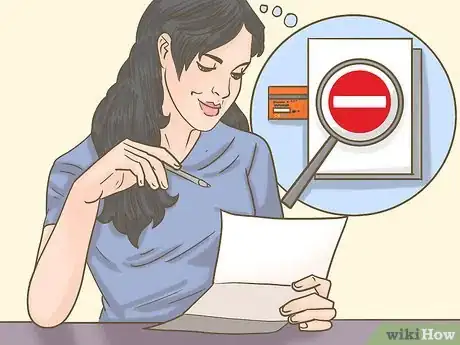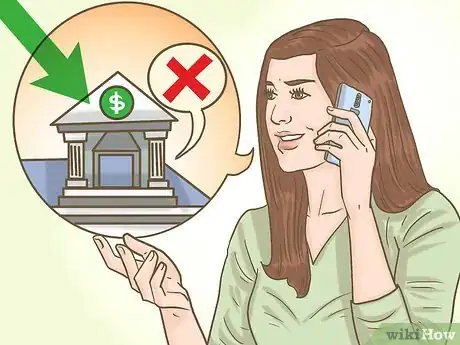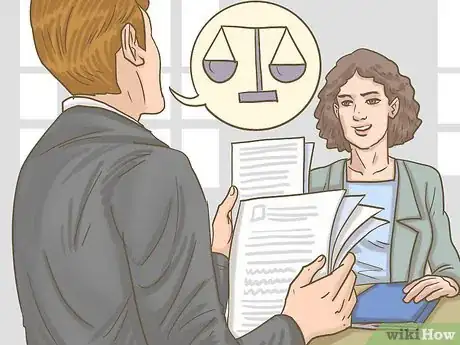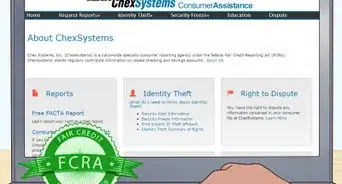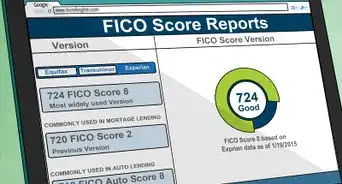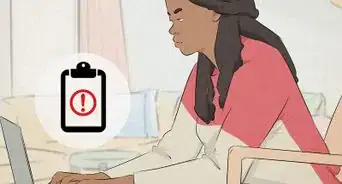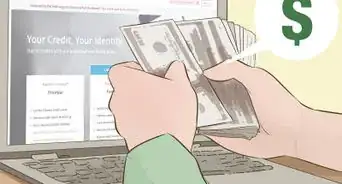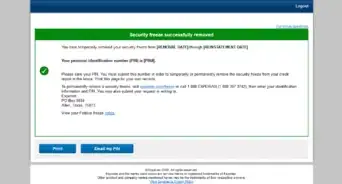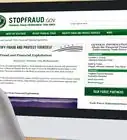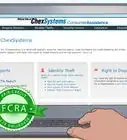This article was co-authored by wikiHow Staff. Our trained team of editors and researchers validate articles for accuracy and comprehensiveness. wikiHow's Content Management Team carefully monitors the work from our editorial staff to ensure that each article is backed by trusted research and meets our high quality standards.
There are 7 references cited in this article, which can be found at the bottom of the page.
This article has been viewed 28,443 times.
Learn more...
Incorrect information on your credit report can impact your credit score and can therefore affect your ability to secure a loan, mortgage, or credit card. Closed accounts, or accounts that you’ve fully paid, can stay on your credit report for up to 10 years. You might want to remove these accounts from your credit report as they can indicate to banks or other companies what your credit habits are. Removing them can be difficult, but is by no means impossible.
Steps
Identifying What Can Be Removed
-
1Obtain a copy of your credit report. The three national credit bureaus, Experian, Equifax, and TransUnion, are required to send you one free credit report each year.[1]
- The best place to get your free credit report is https://www.annualcreditreport.com/index.action, the only authorized website for free credit reports.
- If you’ve already used up your free reports for the calendar year, you can also contact the credit bureaus and ask them to send you another copy. Unfortunately, you’ll probably have to pay a fee for the second copy.
-
2Check your credit report for items on it longer than they should be. For a closed account to be removed, it must have been on the report for longer than 7 years. [2]
- Accounts closed in “good standing,” that is accounts that were fully paid off, can remain on your report for up to 10 years before they are removed. [3]
- Accounts that were not fully paid off when closed can remain on your credit report for 7 years.
Advertisement -
3Ensure the closed account is negative information. There is no law requiring credit bureaus to remove information from a report that has been reported accurately, can be verified, and has no negative information. [4]
- In cases such as this, the information will remain on your account for up to 10 years.
-
4Make sure the negative information should not be on the report. If the information regarding the closed account is not accurately reported or has been present on the report for more than 7 years, it can be removed from the credit report. [5]
Disputing the Report
-
1Send a letter of goodwill to the bureau first before filing a dispute. This is basically a request sent from you to the credit bureau asking them nicely to remove the information from your report..[6]
- The bureau is not required to accept your request in any way. However, in some cases you might get lucky and the bureau will accept your request.
- Make sure to include information such as your name, address, social security number, and your phone number.
- Start off the letter by saying "Thank you for your time and patience in reading this letter. I am writing to you because..." Explain your reasons for writing, why you think the closed account should be removed, and then finish the letter saying "Once again, thank you for your help. It would be fantastic if you could help me get this closed account removed from my report."
- The letter should be written in a sincere, appreciative tone.
-
2File a dispute if the goodwill letter fails. The three main credit bureaus all recommend that you file your dispute online for the fastest response. You can also file the dispute by posting it to the bureau.[7]
- For a dispute with Equifax go to: https://www.equifax.com/personal/disputes/#
- For a dispute with Experian go to: https://www.experian.com/disputes/main.html
- For TransUnion disputes go to: https://dispute.transunion.com/dp/dispute/landingPage.jsp
- You will be asked to identify which account and which information you want removed.
- You will also need to supply documentation regarding the claims you are making in your dispute.
-
3Contact the creditor directly for best results. The creditor can contact the bureau directly and ask them to remove incorrect information from a customer’s report. Either contact the creditor by phone or email and use an appreciative, friendly tone. [8]
- If it was the creditor who reported the information incorrectly, they might deal with the dispute with the bureau for you.
- However, don't get too optimistic. The creditor won't want to jeopardize their relationship with the bureau so they may be reluctant to pursue the matter on your behalf.
Following up on Your Dispute
-
1Wait for a result for up to 30 days. The bureau should follow up on the dispute within 30 days of it being filed. However, most disputes are over within 14 days. [9]
- If your dispute is successful, the bureau must supply you with a free copy of your credit report.
- The bureau may also send details of the corrections made to your credit report to anyone who received it in the last 6 months if you decide you want them to.
-
2Look over the dispute summary. When the investigation is finished, the bureau will send you out a detailed report of what was decided and why. If it was accepted, the bureau will remove the closed account from your credit report.[10]
- If it was rejected, it may be because the closed account was not negative information, it was not on your credit report for longer than it should have been, and it was not false in nature.
-
3Review the credit report to make sure your dispute was just if it failed. If your dispute was not accepted, go over your credit report again. Remember that the information must be negative and present on the report longer than it should be or must be false in nature to be removed.[11]
- What you might view as negative information and what the bureau view as negative information could very easily be 2 different things.
-
4Contact the data furnisher directly if the dispute was not accepted. If the bureau rejected your dispute and the dispute originated with your bank or credit card company, contact them directly by phone or email and explain your situation.[12]
- It might be easier to work out the issue with the data furnisher, especially if the information they provided the bureau is incorrect.
-
5Add the dispute to your report for future reference. You can still contact the bureau and ask them to add details of the dispute to your credit report if it failed. They are obligated to do this so either call them or email them if you would like it to be added.[13]
- This can help explain what happened to anyone who might be reading your credit report.
-
6File a complaint if all else fails. If you’ve gone through every other avenue and you’re still unsuccessful, you can file a complaint against the bureau with the local consumer financial protection agency or another local department. This should only be done when you are sure that the closed account does not belong on your report. [14]
- Explain what happened as thoroughly as possible to allow the agency to adequately investigate the situation.
Warnings
- Be wary of credit repair companies. It’s easy to want a quick fix for your situation, but credit repair companies can cause a lot more hassle and frustration in the long run.⧼thumbs_response⧽
References
- ↑ https://www.ftc.gov/faq/consumer-protection/get-my-free-credit-report
- ↑ https://www.consumer.ftc.gov/articles/0151-disputing-errors-credit-reports
- ↑ https://www.sapling.com/4759725/closed-accounts-removed-credit-report
- ↑ https://www.consumerfinance.gov/ask-cfpb/is-it-possible-to-remove-accurate-negative-information-from-my-credit-report-en-1249/
- ↑ https://www.consumerfinance.gov/ask-cfpb/is-it-possible-to-remove-accurate-negative-information-from-my-credit-report-en-1249/
- ↑ https://www.clearpoint.org/blog/how-to-write-goodwill-letter-diy-credit-repair/
- ↑ https://www.consumer.ftc.gov/articles/0151-disputing-errors-credit-reports
- ↑ https://www.consumer.ftc.gov/articles/0151-disputing-errors-credit-reports
- ↑ https://www.consumer.ftc.gov/articles/0151-disputing-errors-credit-reports
- ↑ https://www.consumer.ftc.gov/articles/0151-disputing-errors-credit-reports
- ↑ https://www.consumer.ftc.gov/articles/0151-disputing-errors-credit-reports
- ↑ https://www.consumer.ftc.gov/articles/0485-sample-letter-disputing-errors-your-credit-report-information-providers
- ↑ https://www.consumer.ftc.gov/articles/0151-disputing-errors-credit-reports
- ↑ https://www.consumerfinance.gov/about-us/newsroom/consumer-financial-protection-bureau-now-taking-complaints-on-credit-reporting/
About This Article
Closed accounts on your credit report may contain negative information about you, but luckily there are some ways you can get them removed. If the information has been on your record for at least seven years, try writing a goodwill letter to the credit agency to request its removal. The letter should include your personal details and information about the account. If the agency doesn’t act on your letter, you’ll need to file a dispute. Disputes can be filed online on your credit bureau’s website, or you can send it by post. You’ll need to attach documents to back up the claims you’re making. Expect to wait up to 30 days for a response. To learn how to understand a dispute summary sent by your credit bureau, read on!








